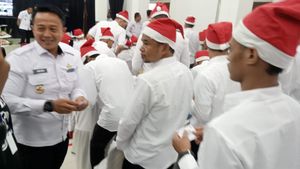JAKARTA - North Korea said it tested the intercontinental ballistic missile (ICBM) on Thursday, increasing what it calls the "strongest strategic weapon in the world", as Seoul warned Pyongyang could acquire missile technology from Russia to help fight in Ukraine.
North Korean leader Kim Jong-un comes live, saying the trial was a warning to an enemy who had threatened North Korea's security, state news agency KCNA said.
"The trial is the right military action that fully meets the goal of informing competitors, who have deliberately stepped up regional situations and pose a threat to the security of our Republicans recently, about our desire to fight back," Leader Kim was quoted as saying by KCNA.
Thursday's launch comes amid a storm of international condemnation and growing concerns by the United States with a number of countries over the deployment of 11,000 North Korean troops to Russia - 3,000 of which are close to the western front line with Ukraine.
The launch drew strong criticism from South Korea, Japan, and the United States.
The day before, Seoul reported signs North Korea might test the launch of the ICBM or conduct its seventh nuclear test ahead of the US presidential election on Tuesday, with the aim of drawing attention to its growing military power.
Separately, Shin Seung-ki, head of North Korea's military research at the government-run Korea's Institute of Defense Analysis, said the launch was likely to test the improvement in the performance of existing ICBM boosters, perhaps with the help of Russia.
"North Korea will continue to get assistance like this, because it saves time and costs while improving performance and improving the stability of the weapon system," he said.
Once under pressure over his involvement with Russia, "he meant it was possible to show they would not be subject to pressure, that they would respond to force with force, and also to gain influence on the US presidential election," Shin added.
South Korea said Thursday morning's launch was North Korea's longest-lasting ballistic missile test with a travel time of 87 minutes, according to South Korea.
Meanwhile, KCNA said the test broke a new record Pyongyang missile capability.
The missile took off with a very high trajectory from the area near the North Korean capital and crashed about 200 km (125 miles) west of Okushiri Island, Japan, off the coast of Hokkaido.
SEE ALSO:
The missile reached an altitude of 7,000 km and flew as far as 1,000 km, the Japanese government said.
The very high trajectory of a very high-angle flying projectile is intended to test its thrust and stability at a much shorter distance compared to the range designed, partly for safety reasons and to avoid the political impact of long-range missile shipments to the Pacific.
North Korea's last ICBM, dubbed the Hwasong-18, was tested in December last year. Supported by a solid propellant and fired from a highway launcher, the missile was also launched at a very high angle and flew for 73 minutes, meaning a potential range of 15,000 km (9,300 miles) on a normal trajectory. The distance can be reached by any region on the mainland of the United States.
The English, Chinese, Japanese, Arabic, and French versions are automatically generated by the AI. So there may still be inaccuracies in translating, please always see Indonesian as our main language. (system supported by DigitalSiber.id)


















